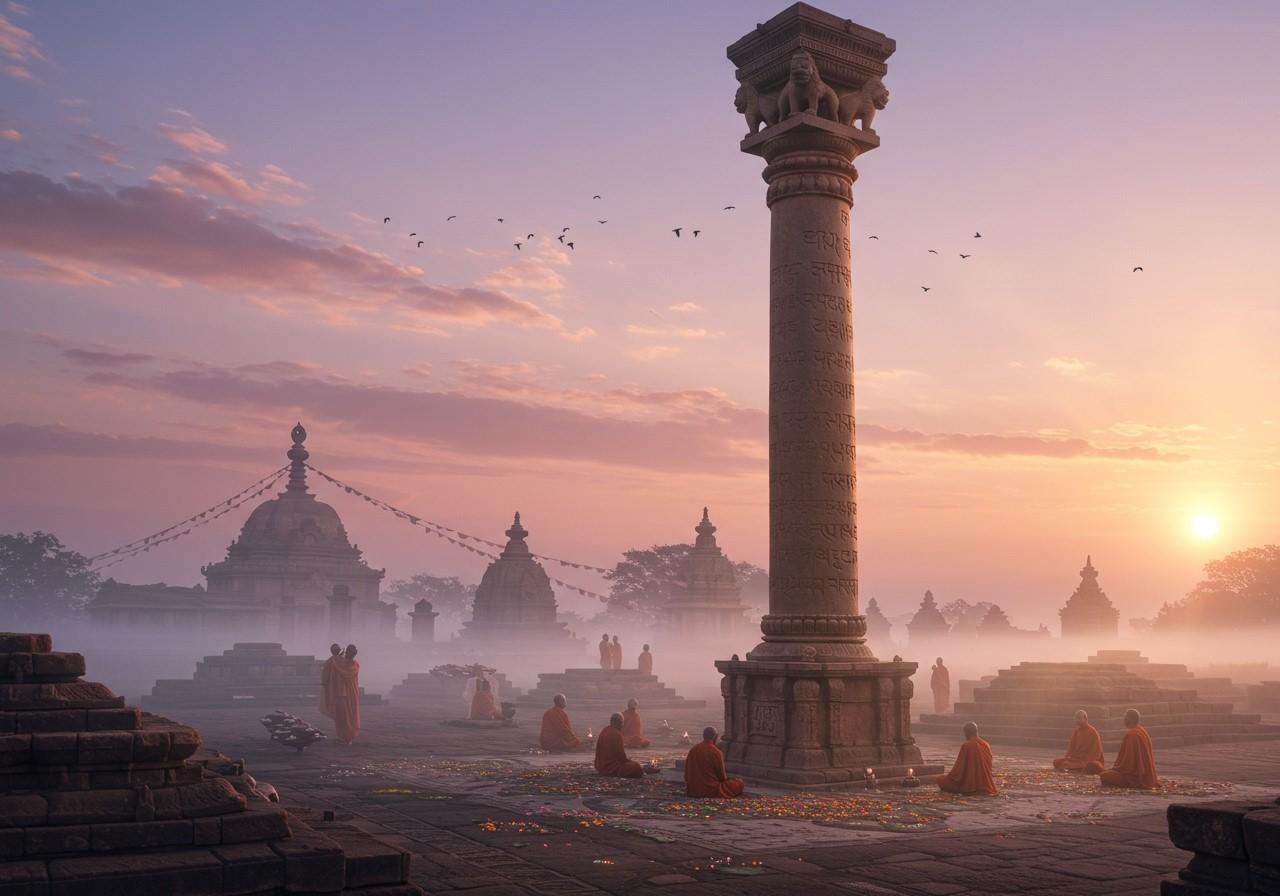
Lauriya Nandangarh, a significant historical site in India, houses one of the most well-preserved Ashokan Pillars. This majestic pillar stands as a testament to the rich cultural and historical heritage of ancient India. Let’s explore the history, architectural brilliance, and significance of the Ashokan Pillar at Lauriya Nandangarh.
Historical Background
Ashokan Pillars date back to Emperor Ashoka’s reign (around 268 to 232 BC). Ashoka, initially a ruthless conqueror, transformed into a benevolent ruler who embraced Buddhism. These pillars, also known as “pillars of the Dharma,” spread Buddhist teachings and moral edicts across the Mauryan Empire, extending across northern India and into areas now known as Nepal, Pakistan, Bangladesh, and Afghanistan. Ashokan Pillars are found throughout the region, each a symbol of historical significance. The Mauryan Empire was known for its advanced administration and architectural achievements. Lauriya Nandangarh stands as an important archaeological site with rich historical relevance.
Architectural Brilliance
The Ashokan Pillar at Lauriya Nandangarh is a monolithic structure carved from a single piece of sandstone. It stands approximately 32 feet tall and features intricate carvings and inscriptions in Brahmi script. The lion capital atop the pillar symbolizes power and sovereignty. The precise engineering techniques used to erect this massive structure were remarkably advanced for its time. Comparable to other famous Ashokan pillars in Sarnath (marking where Buddha first taught the Dharma) and Sanchi, Lauriya Nandangarh’s pillar is equally impressive in design and durability.
Cultural and Religious Significance
The Ashokan Pillar played a vital role in promoting Buddhism and spreading Ashoka’s moral edicts, over 150 of which have been found on rocks, cave walls, and pillars. The inscriptions offer guidelines based on Buddhist principles, unifying diverse populations under a common ethical framework. The lion capital is now India’s national emblem, symbolizing pride and heritage. The pillar remains revered among Buddhists and historians, serving as a pilgrimage site and a destination for religious tourism.
Preservation and Conservation Efforts
The current state of the Ashokan Pillar at Lauriya Nandangarh is maintained by the Archaeological Survey of India (ASI). Preservation faces challenges like weathering and environmental damage. Restoration work protects inscriptions and carvings. Public awareness and education are crucial for preserving cultural heritage sites. Local and governmental initiatives promote heritage tourism in Lauriya Nandangarh. Technology and modern techniques aid in conserving ancient monuments.
Visiting Lauriya Nandangarh
Lauriya Nandangarh is accessible for those exploring India’s rich history. The best time to visit is during the cooler months, from October to March. Lauriya Nandangarh is reachable by road from major cities like Patna and Darbhanga. Nearby attractions include other historical sites such as the Kesaria Stupa. Local accommodations provide comfortable stays, while regional cuisine offers local flavors. Guided tours enhance understanding of the site. Responsible tourism ensures these historical treasures are preserved for future generations.
Poojn.in Enhances Your Spiritual Journey
Poojn.in, India’s largest online store for cultural and religious goods, offers authentic products that connect you with the spiritual significance of Ashoka and the heritage of the Lauriya Nandangarh pillar. We provide:
- Pure Ashoka Chal Powder (Saraca asoca bark powder): Available in various quantities, ideal for traditional rituals and connecting with the essence of Ashoka’s legacy. Experience the purity and authenticity of this sacred ingredient.
- Complete Pooja Samagri Kits: Containing authentic materials for performing rituals with reverence and respect, ensuring a complete and fulfilling spiritual experience. Find everything you need in one convenient kit.
- Traditional Holy Utensils: Crafted for ceremonial purposes, adding a touch of tradition and sanctity to your practices. Elevate your spiritual experience with these sacred tools.
Explore our extensive collection of pooja items and dashakarma materials, carefully sourced and verified for authenticity. Contact our customer service team at +91 7908548235 for any questions. Visit Poojn.in to discover our full range and experience the convenience of India-wide delivery.
Conclusion
The Ashokan Pillar at Lauriya Nandangarh is a remarkable symbol of India’s ancient history and rich cultural heritage. Its carvings, historical significance, and architectural brilliance make it a must-visit. Preserving such treasures honors our ancestors’ legacy and keeps the spirit of our traditions alive. Visiting Lauriya Nandangarh connects you with India’s glorious past while appreciating the efforts to conserve these invaluable monuments. Embrace the beauty and history of the Ashokan Pillar and deepen your appreciation for our rich cultural heritage.
FAQs about Lauriya Nandangarh: The Majestic Ashokan Pillar – History and Significance
What is the Lauriya Nandangarh Ashokan Pillar? The Lauriya Nandangarh Ashokan Pillar, located in West Champaran, Bihar, India, is one of the many pillars erected by Emperor Ashoka during his reign (circa 268 to 232 BC).
What is the significance of the pillar? It holds historical and religious significance, representing Ashoka’s efforts to spread Buddhism and his messages of peace, morality, and dharma (righteous conduct).
Where is the pillar located? The pillar is situated in Lauriya Nandangarh, a village in the West Champaran district of Bihar, India.
What is the height of the pillar? The Lauriya Nandangarh Ashokan Pillar stands approximately 32 feet (9.75 meters) tall.
How old is the pillar? The pillar dates back to the 3rd century BCE, the era of Emperor Ashoka’s reign.
Are there any inscriptions on the pillar? Yes, the pillar features inscriptions in Brahmi script, conveying Ashoka’s edicts and messages.
What is the difference between the Lauriya Nandangarh and Lauriya Areraj Ashokan Pillars? Both pillars are part of the series of Ashokan pillars but located in different villages within Bihar. Each pillar has unique features and inscriptions.


